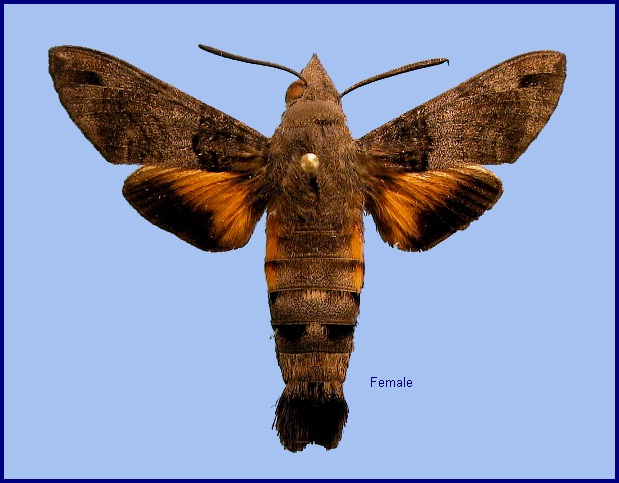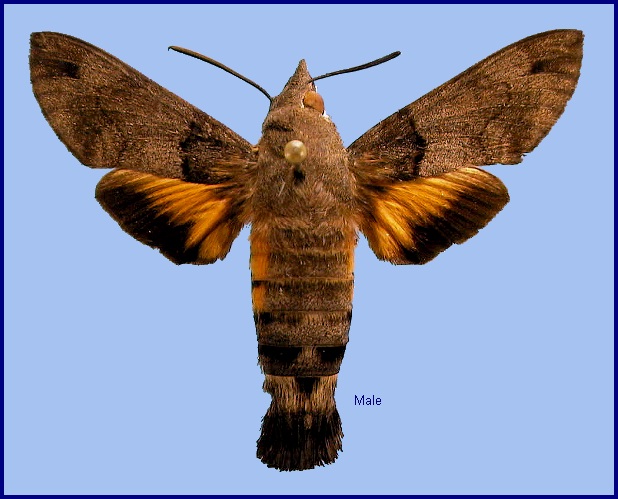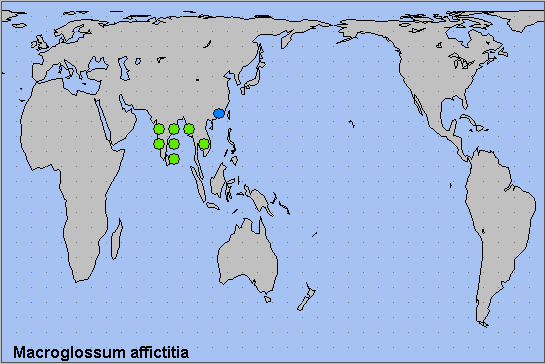

Macroglossa affictitia Butler, 1875, Proc. zool. Soc. Lond. 1875: 240. Type locality: [India, Karnataka,] Canara [Kanara].
Synonym. Macroglossa vialis Butler, 1875.
Synonym. Macroglossum fischeri Eitschberger, 2009.
Wingspan: 16--22mm. Similar in colour to Macroglossum gyrans. Forewing upperside with antemedian black double lines prominent, close together, the space between more or less filled with black; median area grey; discal lines thin, not prominent; a dark area on the disc between veins M1 and Cu2. Hindwing upperside with base and broad distal border band blackish brown; median band yellowish orange or more tawny. Antenna with terminal segment longer than in Macroglossum gyrans. Abdomen upperside with base of seventh tergite less extensively and less pure white than in Macroglossum gyrans, this belt generally only clear when the segment is removed. Sides of thorax and legs dull drab-russet. Abdomen underside, without white mesial patches; underside of tail the same colour.
In the male genitalia, uncus somewhat rounded at the sides just before the pointed apex. Gnathos not black, rather flat, apex rounded. Valve without stridulatory scales. Harpe sharply pointed. Phallus with apical process long, acute, projecting distad basally, dentate at proximal edge, but not dentate at and near base; two rather broad internal rods.
The moth makes a deep humming note before flight by a quivering motion of the wings. It does not appear to be attracted by light (Bell & Scott, 1937).
OVUM: Colour pale olive-green, almost spherical (1 x 0.85mm), surface smooth and shiny (Bell & Scott, 1937).
LARVA: Full-fed 40mm. According to Bell & Scott (1937), in the first instar head round, body cylindrical. Horn subcylindrical, tip truncate with a setiferous point at each lateral angle of the truncation, directed laterad. Body surface smooth and shiny; horn covered densely with tubercles. Head orange; body olive-green, segments 11 to 14 paler than the rest; horn dull black. In the second instar head pale orange, body darker olive-green, segments 2 and 11 to 14 paler. There is a greyish dorso-lateral stripe from segment 3 to base of horn. By the third instar, horn shiny, set with strong, pointed, setiferous tubercles; head degraded orange; body dark olive-green above, pale olive-green below. There is a broad, well defined dorso-lateral stripe running from segment 2 to base of horn; segment 14 yellowish. In the fourth instar, surface dull except for the horn, true legs and prolegs, which are shiny; horn tuberculate as in third instar. Head and body smoky-black, dotted with yellow below the dorso-lateral stripe; this stripe broad, yellowish-green; horn black.
In the final and fifth instar, head small, round; true clypeus with apex acute, half length of head; false clypeus forming a narrowly rounded arch over apex of true clypeus, apex reaching to two-thirds length of head; ligula kidney-shaped; cutting-edge of mandible shallowly toothed. Surface of head dull, minutely shagreened and covered with low, shiny tubercles; ligula shiny. Body dull and smooth, covered with minute hairs. Horn straight, rising from a fleshy cone. Distal two-thirds of anal flap, clasper faces, and legs and prolegs shiny.
Colour variable. In one form the is head dull black, the tubercles whitish; labrum, ligula and antenna pale yellow; mandible pale yellow, tip blackish. Segment 2 dull black; 3 to 11 smoky-black, dotted with yellow especially on dorsum. There is an obscure black dorsal stripe on 3 to 11, expanding into black patches near the front margins of 8 and 9, and an obscure dorso-lateral stripe, edged below by black, on 3 to 11. Anal segments pale brownish-pink suffused with fuscous laterally. Horn, distal two-thirds of anal flap, clasper sides and true legs black; there is a black ventral stripe. Spiracles rather large, oval, flush, rich orange tipped with whitish at the upper and lower ends.
There is also a green form in which the head is green dotted with yellow, with a white stripe separating face from cheek. Body green dotted with yellow; a pale indigo dorsal stripe from segment 3 to base of horn; a narrow dorso-lateral stripe from 2 to base of horn, yellowish on 2 to 4 and white to base of horn, broader on 10 to 12; there is also a yellow subspiracular stripe from 2 to tip of anal flap. Horn green with the tip and tubercles black; true legs shiny black, Spiracles orange, the ends shortly yellow.
In another form the head is pinkish-yellow, mouthparts green; body delicate pink dotted with yellow; dorsal stripe pale blue; dorso-lateral stripe yellowish on segments 2 to 4, then white; horn orange, tubercles and tip black; segment 14 and anal flap green dotted with white. Spiracles orange with the ends white.
In yet another form the head is black; body black dotted with white, dorsum brownish, violet-brown or drab; the longitudinal stripes sometimes broken or wanting; horn and true legs shiny black; venter pinkish.
These are the principal colour-forms, but intermediate forms also occur, and all are subject to variation. The only constant marking is the dorso-lateral stripe.
The full-fed larva, when alarmed, raises the front part of the body, throws the head back over the dorsum, and ejects green fluid from the mouth. Before pupation it turns a livid pinkish colour (Bell & Scott, 1937).
PUPA: 30mm, width 8.5 mm. Colour degraded greenish-white; wing-case covered with leaden-grey reticulations; tongue, antenna, legs and veins of wings rusty; thorax with a leaden-grey dorsal stripe and an obscure rusty dorso-lateral stripe; abdomen with a diffuse dark dorsal stripe and suffused with pinkish rust-colour; spiracles black, the central slit orange-brown; cremaster black. In shape the same as that of other macroglossine pupae. Tongue-case not very prominent; tip of tongue rounded and depressed; antenna slightly longer than fore leg; with a short narrow coxal piece. Surface moderately shiny; head, thorax and wing case very shallowly, irregularly corrugate, veins of wings raised; abdomen pitted except for a narrow band near the hind margin of each. There is no sculpturing on segment 4, and front bevel of 9 with a number of short, closely set ridges. Spiracle of 2 a narrow slit, with a raised oblong transverse lobe projecting from 3 behind it, and an emargination of the hind margin of 2 in front of it; remaining spiracles oval slightly raised. Cremaster triangular, tip narrowly truncate, a small pointed tubercle at each lateral angle of the truncation; ventral surface slightly; hollowed longitudinally and with a rounded central keel (Bell & Scott, 1937).
Larval hostplants. Strychnos (Loganiaceae) and Morinda (Rubiaceae).
China: ?Yunnan. (This is an unconfirmed record.)
From Sri Lanka and southern India to Burma/Myanmar, Thailand, Vietnam (Le & Vu, 2024) and ?southwestern China (Yunnan).

 Return to Sphingidae of the Eastern Palaearctic species list
Return to Sphingidae of the Eastern Palaearctic species list